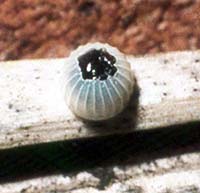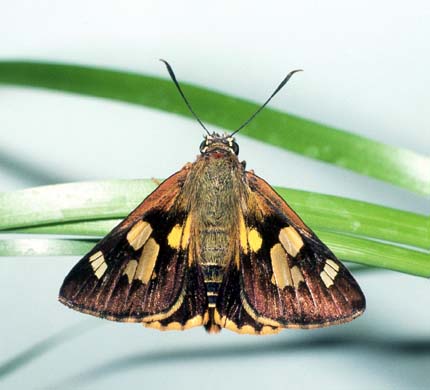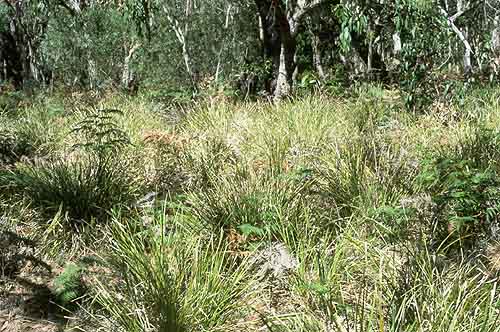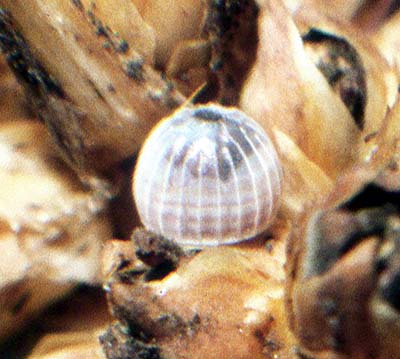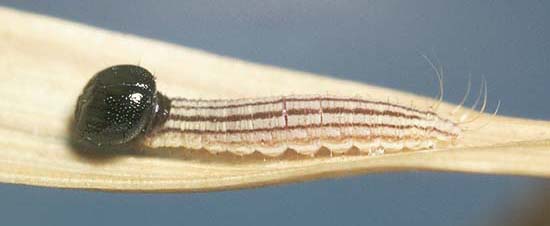-
Larval Food Host
-
Lomandra longifolia (spiny-headed mat-rush) (Asparagaceae).
The larvae feed on the leaves.
-
Eggs
-
Large, initially pale yellow, hemi-spherical (domal) with strong vertical ribs
numbering 21-24. If the egg is fertile, then after a couple of days it acquires
a large red-brown dorsal spot and a jagged red-brown lateral band. Eggs are laid
singly anywhere on the hostplant, usually on plants situated in partial shade.
Larval development within the egg commences immediately after being laid. The egg
shell is eaten by the larva after its emergence.
-
Larvae
-
The first instar is initially pale greyish yellow with longitudinal dark brown
lines, and has a large slightly rugose black head with a few long hairs, the
neck (prothoracic plate) is black, and long recurved hairs occur posteriorly.
The yellow colour gradually becomes green as it eats the hostplant.
Subsequent instars gradually become brownish, and lose the longitudinal lines
and long hairs, and the head becomes brown and eventually acquires the pattern
of the final instar.
The final instar is about 35-40 mm long, fat and humped, pinkish-brown with a
darker dorsal line and further indistinct longitudinal subdorsal lines. The
head is large, rugose, strongly notched at the top, dark brown with a broad
inverted orange Y mark on the front, edged yellow, and with very short, curved
flattened setae. The body is without long hairs, but bears numerous wine-glass
shaped secondary setae set on simple smooth raised bases. These setae impart
a rough scabrous appearance.
Larvae construct shelters opening at the top, initially near the base of the
hostplant, by joining several hostplant leaves together to form a tight, silk
lined tubular structure. Later they may use loose extraneous curled leaf debris
within or around the base of the hostplant. They feed at night, usually very
late at night, hiding from predators during the day inside their shelter.
The presence of larvae on the hostplant are readily discernible by the distinctive
large jagged eat marks along the upper edges of the strap-like leaves. The larvae
feed throughout winter and spring, and pupation takes place in early summer.
The larva stage can require five or six instars to maturity.
-
Pupae
-
Brown with darker markings, long cylindrical and fat, about 25-28 mm long,
head rounded and very rugose. There is a pair of large black half crescent
shaped raised areas situated subdorsally behind the head. The head cap
(operculum) has two unequal pairs of small protuberances, the most anterior
pair being larger and have a short blunt horn shape, while the smaller more
dorsal pair are rounded and black spotted. The abdomen, thorax and parts of
the head are bristly, with the setae being flattened and hockey stick in shape.
The cremaster is black coloured, very long, curved and spinose. Pupation occurs
either in the final larval shelter on the hostplant, or more usually the larva
may leave the hostplant to pupate, sometimes many metres distant from the plant.
The pupal duration is about three weeks.
-
Flight Period in South Australia
-
Early January to early March. Only one brood a year.

-
Distribution
-
In South Australia it is confined to the Lower Southeast Region, and is found only
where its hostplant occurs. It occurs in similar habitat to Trapezites eliena,
but is very local in its distribution and is presently only known from four areas.
The local subspecies of the skipper is also found in western and central Victoria.
Two other subspecies occur coastally in the eastern states and in the eastern Great
Dividing Range as far north as central Queensland.

-
Habitat
-
Usually occurs in open forest containing its hostplant, which requires moist
conditions. Prefers its hostplant to be in partial shade and uncongested by
other plants.
-
Conservation Status in South Australia
-
Although it is locally common at three of its known sites it is considered to be
vulnerable within South Australia based on the small area of its presence, even
though the hostplant is widespread. In the adjacent areas of Victoria it is locally
common. Known sites are secure.
-
Threats
-
The skipper is confined to the remaining habitats of its hostplant, which is subject
to the continuous threats of urban, agricultural and forestry requirements. The main
threat is bushfire, which could quickly destroy the three main sites as they occur
near to each other. Remaining areas of hostplant are now severely fragmented.
-
Conservation Strategy
-
Its hostplant needs to be reintroduced to all conserved areas in which it originally
occurred. Additional areas may need to be conserved and repopulated with hostplant,
as suitable native open forest habitat, uncongested by other understorey plants,
particularly bracken, is now rare. The hostplant is a good candidate for growing in
urban gardens in the Lower Southeast, as it is tough, easily grown and looks good.
Use of the plant in the urban and roadside environment in the eastern states has
shown a large increase in the T. symmomus butterfly population. (The local
hostplant should be used, as the plant presently sold in nurseries originates from
Melbourne and has a much broader leaf, and is silvery coloured rather than glossy green.)



